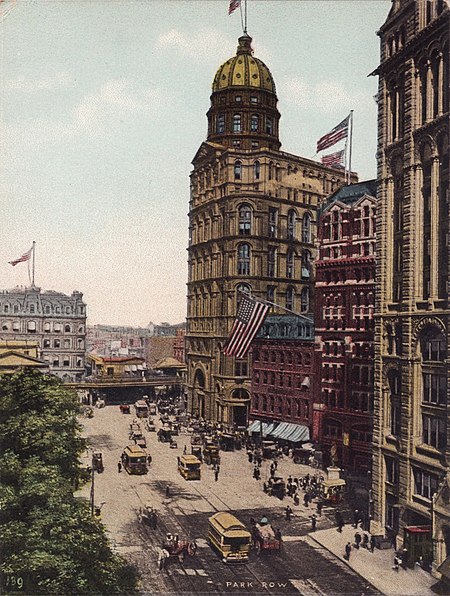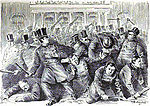New York World Building

The New York World Building (also the Pulitzer Building) was a building in the Civic Center of Manhattan in New York City, along Park Row between Frankfort Street and the Brooklyn Bridge. Part of the former "Newspaper Row", it was designed by George B. Post in the Renaissance Revival style, serving as the headquarters of the New York World after its completion in 1890. The New York World Building was the tallest building in New York City upon completion, becoming the first to overtop Trinity Church, and was by some accounts the world's tallest building. The World Building contained a facade made of sandstone, brick, terracotta, and masonry. Its interior structure included brick interior walls, concrete floors, and an internal superstructure made of iron. There were twelve full stories, two basements, and a six-story dome at the top of the building. The pinnacle above the dome reached 350 feet (110 m). When the building was in use, the World primarily used the dome, ground floor, and basements, while the other stories were rented to tenants. The World Building's design generally received mixed reviews, with criticism focusing mostly on its immense scale. The World's owner Joseph Pulitzer started planning for a new World headquarters in the late 1880s, and hired Post to design the building as a result of an architectural design competition. Construction took place from October 1889 to December 1890. Following the World's subsequent success, Horace Trumbauer designed a thirteen-story annex for the World Building, which was erected between 1907 and 1908. When the World closed in 1931, the building was used as headquarters of The Journal of Commerce. The World Building was demolished between 1955 and 1956 to make room for an expanded entrance ramp to the Brooklyn Bridge. A large stained glass window and the building's cornerstone were preserved by the Columbia University School of Journalism.
Excerpt from the Wikipedia article New York World Building (License: CC BY-SA 3.0, Authors, Images).New York World Building
Park Row, New York Manhattan
Geographical coordinates (GPS) Address Nearby Places Show on map
Geographical coordinates (GPS)
| Latitude | Longitude |
|---|---|
| N 40.712 ° | E -74.0053 ° |
Address
Nassau Street & Frankfort Street at Southeast Corner
Park Row
10000 New York, Manhattan
New York, United States
Open on Google Maps








